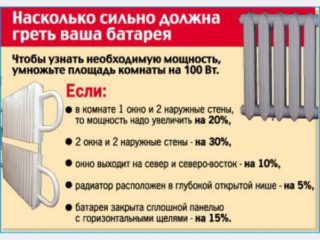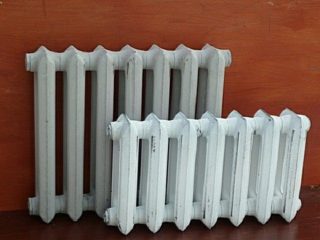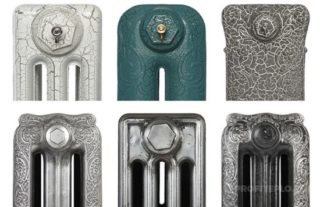Cast iron batteries - a standard heating device, adapted to the working conditions of central heating. The characteristics of cast-iron radiators correspond to the system requirements. They are resistant to corrosion and not too demanding on the purity of the coolant, insensitive to pressure drops and durable.
Design features of cast iron radiators
Batteries have the most traditional look. The design includes several sections interconnected by nipples. To seal the joints, use heat-resistant rubber or paronite. The channels for the coolant inside have a round or elliptical cross section. Produce single, dual and three-channel sections.
Batteries are cast from gray cast iron. The material is resistant to wear and durable - radiators serve more than 50 years. Salts on the walls are not deposited, fine debris or sand does not cause damage. Even after 30–40 years, the diameter of the working channels remains almost unchanged.
The size of the cast iron battery depends on the number of sections. The size is selected based on the size of the heated room. But if the width of the product is determined by the number of elements, then the height and depth depends on the structure of the sections themselves.
The appearance of the product is unattractive. More modern models are released with a flat front panel. Decorated with forged elements.
Advantages and disadvantages
The advantages of the product are due more to the material than the design. The main advantages:
- Cast iron conducts heat well and accumulates it. The radiator heats up longer than steel or bimetallic, but gives off heat after turning off the boiler for a long time. An hour after the cessation of heating, the residual heat transfer of cast iron models is 30%, while that of steel models is only 15%.
- The water used in central heating is not clean. Salts, solids, sand destroy the pipeline material. Debris is deposited on the walls: the working diameter decreases with time, the heat transfer efficiency decreases. Cast iron is not afraid of salts, abrasive particles. After 30 years, the batteries work as efficiently as they did on the first day after release.
- Cast-iron batteries do not withstand the constant high pressure of water, but she is not afraid of water hammer. This option is used when arranging heating with natural circulation.
- Radiators serve at least 50 years. If the gaskets are changed on time, even longer. Usually they are replaced not because of leaks or low efficiency, but wanting to make the interior more modern.
- The price is the lowest among heaters.
Cons of radiators:
- The main disadvantage is the considerable size and heavy weight. A model of 8 sections weighs over 60 kg. They are difficult to transport, lift to the upper floor, mount.
- If, when the heating is turned off, high thermal inertia is a virtue, when turned on, it turns into a disadvantage. The room warms up for at least 12 hours.
- To service the batteries, you need a large volume of coolant and a more powerful boiler. For central heating, this is not a hindrance, since the system was originally designed to transfer a large amount of coolant. For autonomous, this is a significant drawback.
- There is no need to talk about design. Rough heavyweight radiators hardly fit into the interior.
The advantages of a cast-iron battery are well manifested in central heating systems. Disadvantages are visible when equip autonomous heating.
Specifications
The choice of cast iron batteries is small. Most of the older models were abandoned.In the new ones, they are trying to reduce the volume of coolant, improving heat transfer due to a larger number of channels and creating a flat surface.
Technical specifications of the most popular models are given below.
| Mark | Working pressure, atm | power, kWt | Heating area for 1 section, sq. m | The volume of water in 1 segment, l | Weight of 1 segment, kg |
| MS-140 | 9 | 0,12–0,16 | 0,244 | Up to 1.45 | 5,7–7,1 |
| World Cup 1 | 9 | 0,075–0,11 | Up to 0.165 | Up to 0.9 | 3,3–4,8 |
| World Cup 2 | 9 | 0,1–1,14 | Up to 0.207 | Up to 0.95 | 4,5–6,3 |
| World Cup 3 | 9 | 0,1–0,15 | Up to 0.246 | Up to 1.38 | 4,8–7 |
Models are selected mainly by power. Comparison of the characteristics of the sections allows you to quickly calculate the required dimensions of the heater.
Height
 A parameter that affects not only heating efficiency, but also aesthetics. The height of the cast-iron standard battery is 59 cm. Models are available with a height of 33 to 95 cm. The working surface of each section varies depending on the height. This is taken into account when calculating their required number.
A parameter that affects not only heating efficiency, but also aesthetics. The height of the cast-iron standard battery is 59 cm. Models are available with a height of 33 to 95 cm. The working surface of each section varies depending on the height. This is taken into account when calculating their required number.
Low radiators look more attractive even with a standard configuration.
The size
Product dimensions vary greatly:
- height - from 33 to 95 cm;
- depth - from 8.5 to 20 cm;
- width - from 4.4 to 10.8 cm;
- center distance varies from 22 to 90 cm.
Size information is on the label. If the model is non-linear, depth is not indicated.
The most important parameter - the length of the battery itself - depends on the power. The more sections, the larger the area the radiator can heat. However, there is a limitation: if the battery is 4 times longer than the height, it must be connected on both sides, and this is not always possible and convenient.
Power
 The indicator is calculated by the following parameters:
The indicator is calculated by the following parameters:
- volume of the room;
- insulation quality;
- water temperature;
- power of one section of a cast-iron radiator - this indicator is indicated in the product passport.
On average, at a normal level of heat loss, 3 kW of air in a room requires 1 kW to heat.
The calculation is as follows: the area of the room is multiplied by 100 and divided by the power of the sections of the selected model. For example, with an area of 10 square meters. m. and power segment of 150 watts get 10 * 100/150 = 6.67. Round the result up - to heat the room you will need a radiator with 7 sections.
It is advised to increase the calculated value by at least 15%. To heat the bedroom with an area of 10 square meters. m. recommend buying batteries for 9-10 cells.
The height of the room should be considered. With the same area, but with a ceiling height of not 3.5, but 4 m, heating with a radiator of the same power will require at least 12 sections.
Other factors are also considered. If the room has 2 windows, it is better to install 2 batteries of 5 sections in order to evenly distribute heat and neutralize cold air.
Selection rules
The recommendations are simple:
- The most important thing is the correct calculation. Estimate the power of the section and calculate the efficiency of the entire heater. If there are not enough sections, raising the temperature of the coolant will not fix the problem, the room will be cold.
- Need to pick the height. If the product is mounted under the window, at least 20–15 cm should remain between the battery and the window sill, and at least 5 cm between the floor and the bottom edge of the product. For large windows, choose low radiators and compensate for the small height with a large number of sections. High radiators are mounted near blank walls.
- Batteries with a flat surface have a higher efficiency, their appearance is more attractive. Models with artistic molding, with a decorative coating fit perfectly into the interior in retro style, classic, rustic.
- Radiators are fixed on the wall to special brackets. However, there are models in the floor. The latter are used if the walls cannot withstand such a heavy load.
The appearance of the battery can be radically changed by covering them with a decorative grille or screen.
Cast Iron Radiators Manufacturers
Not only Russian factories and enterprises of the CIS countries produce such products.There are many foreign manufacturers offering cast iron radiators in the style of retro or techno. Models of domestic companies are cheaper.
Minsk Heating Equipment Plant
One of the most famous manufacturers. It produces two- and three-channel cast-iron batteries in a very different design. There are classic radiators and models with a flat surface - they are more effective, since they give off heat better, as well as options with a picture on the surface. The number of sections is determined by the customer.
Santekhlit (Russia)
The factory offers classic models. Depth of sections and height varies over a very wide range. There are models with a depth of only 11 cm. They are easy to place under a narrow modern window sill. Battery length is determined by the number of sections.
Viadrus (Czech Republic)
The company offers products more suitable for autonomous heating. Radiators easily withstand a constant pressure of 12 bar, very durable. Conform to European quality criteria.
Attractive radiator design. The plant produces 8 rulers in various designs and in 27 sizes. There are models with a flat surface, with an exquisite pattern in sections, with sections of an unusual irregular shape.





